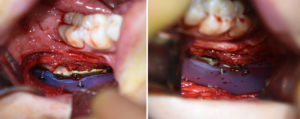Background: The sagittal split mandibular osteotomy (SSRO), most commonly used for lower jaw advancement, is one of the most ingenious of all the craniomaxillofacial osteotomies. Splitting the ramus of the mandible longutudinally into two vascularized bone segments is a technical marvel. It allows the distal tooth-bearing portion of the lower jaw to be moved forward while leaving the proximal TMJ-containing bone segment in place. This maintains good bone contact that is fixed together and heals without creating a bone defect.
While the bones segments of a sagittal split mandibular osteotomy do maintain the shape of the jaw angle during the procedure, the jaw angle shape can adversely change as it heals. Some bony resorption of the jaw angle is not rare as the proximal bone segment not only becomes thinner afterwards but probably suffers some degree of devascularization in some cases. This resorption pattern can make the back of the jaw look thinner with a higher jaw angle shape externally.
Such jaw angle shape deformities after a mandibular osteotomy is more prone in thin jaws, inadvertent fracture patterns (aka ‘bad splits’) and repeat sagittal split procedures. The best diagnosis of the jaw angle shape is a from a 3D CT scan where the two sides can be compared in both frontal and side views.
Case Study: This 22 year-old female had a history of orthognathic surgery consisting of a LeFort I, mandibular sagittal split osteotomies and a sliding geniplasty several years previously. She felt that her lower face was too thin and lacked any definition as well has still had inadequate chin projection.


Highlights:
1) Loss of the jaw angle shape can occur after sagittal split osteotomies due to bone resorption.
2) Jaw angle implants can either restore or augment the shape of the jaw angle.
3) Whether the jaw angle implants should be standard or custom made depends on how much bone resorption has occurred and the amount of bony asymmetry.
Dr. Barry Eppley
Indianapolis, Indiana



